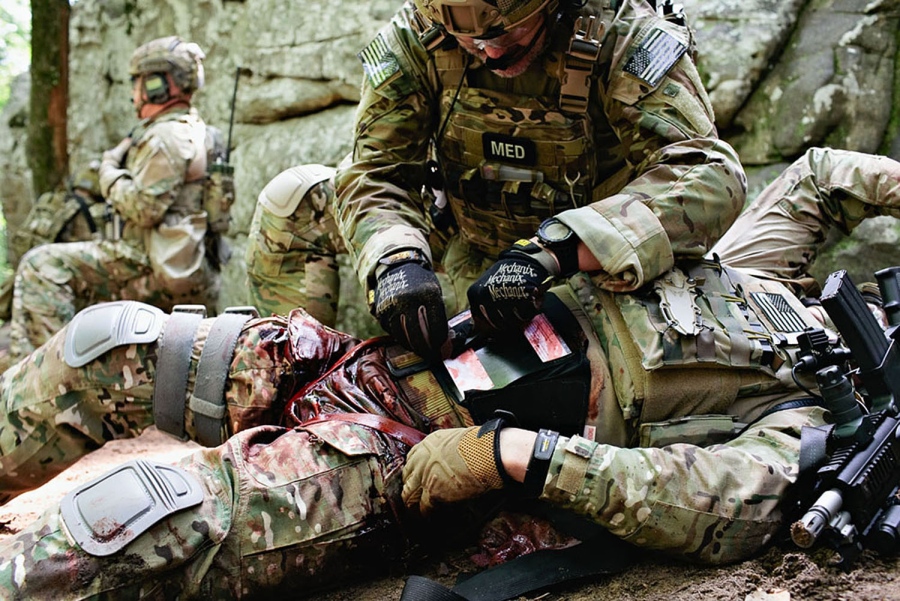good thread
Ill be needing to build up a new kit in a few weeks and this has given me some things to think about rather than just replicating my admitadly old school kit
Welcome guest, is this your first visit? Create Account now to join.
Welcome to the NZ Hunting and Shooting Forums.
Search Forums
User Tag List
+ Reply to Thread
Results 61 to 75 of 88
Thread: First aid kit pics
-
05-02-2018, 12:34 AM #61Using Tapatalk
-
-
05-02-2018, 07:36 AM #62Member

- Join Date
- Feb 2016
- Location
- Stewart island / canterbury
- Posts
- 9,193
That's the whole idea of the forum I guess

@SAVAGE have a look on YouTube, can get an extra 4-5 300mg doses, doeinvolve cutting through the hard outer plastic, inside is a plunger wih a rubber stopper.... Will let you figure the rest out as its not something that should be 'advised' about
-
19-07-2018, 10:43 PM #63Member

- Join Date
- May 2018
- Location
- Dallas, Texas
- Posts
- 15
Never had a fir aid kit with me, now looking at tall this i should start collecting.
-
20-07-2018, 12:12 AM #64
I somehow missed this thread and I'm a serious FA junkie hoarder

Just two things I want to add - firstly, skip the tampons, they cause more issues than they solve. Use a proper trauma dressing.
Second, if you're tramping, keep it to the minimum of what you are capable of using and might need. If you're with a regular buddy, split the kit between you and make sure at least one of you knows more than just how to apply a band aid. I have seen way to many guys lug everything short of an ambulance into the bush and when it goes south, they don't have a clue how to use 90% of their kit.
Surprised nobody has mentioned superglue??
And where are the burn dressings @223nut ?
One thing I also carry is cable ties. Its extreme but if the bleeding doesn't stop, its life over limb - works well for shotgun AD's to the ankle or when you step on a landmine.Regards
Terry
https://www.knives4africa.co.nz/
Custom knife dealer
Authorised Nitecore Torch Retailer
NZ Distributor of Nano-Oil
-
20-07-2018, 07:27 AM #65Member

- Join Date
- Feb 2016
- Location
- Stewart island / canterbury
- Posts
- 9,193
Snaplock bags work as a burn dressing, just need to seal out the air from the nerve endings, gladwrap is ideal but Snaplock bags have others uses
-
20-07-2018, 08:02 AM #66
Superglue great for sealing superficial abrasions and it can be used to appose split skin edges.
Not easy to use superglue for closing split wounds - the wound sides need to be together, and the glue spread over the top of the skin (not in between the skin edges or it will prevents the skin edges growing together). Better to bandage a split wound, since unless you have been able to clean it thoroughly you may trap infection inside it by stitching/gluing. If it is kept clean your doctor CAN suture it at leisure, including more than 24hours after the injury, though some are reluctant to do so.
3M Micropore tape (or Pam's substitute), great for blisters or skin about to blister. It gives you an extra layer of armour.
Combat Action Tourniquets are frankly painful to apply properly, it is not because of them shutting down the blood supply (well, that too) but because they are very narrow and so have to be tighter around the limb to achieve compression of the artery. If you can get hold of a Blood Pressure cuff with an inflator, it will do the same job but with a lot less pain. But direct pressure and elevation of the bleeding limb is the go-to-first option.An itch ... is ... a desire to scratch
-
21-07-2018, 02:31 PM #67Member

- Join Date
- Jan 2018
- Location
- kaiapoi
- Posts
- 7,365
Always have a roll of insulation tape handy. Good for the small stuff and pretty much the only thing I used on myself especially whenI was underground. Always instantly handy.
Apparently there is a very mild antibiotic property in the glue (as told to me by an electrician mind you) but I don't care.
-
23-07-2018, 09:22 PM #68
I've never used a BP cuff as a tourniquet, but having taken as many blood pressures as I have with them, I can tell you that it's really common for them to slowly leak air even when the nut is fully tightened. CATs are a much lower maintenance solution, and more idiot-proof. I think generally if you're bleeding enough to warrant one, the pain involved with a CAT is neither here nor there.
-
23-07-2018, 09:42 PM #69Member

- Join Date
- May 2017
- Location
- Manawatu
- Posts
- 112
I typed out a very similar reply to this a few times but deleted it.
I agree completely, use something that is designed for the job, and learn how to use one correctly. Sure, a pneumatic tourniquet such as the ones used in a hospital may be okay, but your normal BP cuff is bound to cause problems. Plus, who wants to carry a BP cuff around the bush???
-
23-07-2018, 11:40 PM #70
@Solo
@Solo
You're right about the slow leak. I've come across this in many manual tourniquets, I've wondered if some makers do it on on purpose for obvious reasons, e.g. nurse gets called away for emergency while doing a BP on unconscious person. O-:
Forgot the other reason for a wider cuff, which is concern over soft tissue crush damage, esp. to nerves. Not sure if that is just because of using a narrow tourniquet or if it is from applying it unduly tight. It doesn't require much pressure to stop bleeding if someone already is hypotensive from blood loss.
The multi utility duct tape mentioned above can also be used, even a length of rope - just apply it fairly tight in successive overlapping or adjacent turns, until bleeding stops.
@Sonicjoe
The BP cuff is of course a tourniquet. It works by stopping arterial blood flow into a limb by applying even pressure round a limb, compressing arteries against bones. As for the weight problem, yes, good reason to stick to CAT and pack that gaffer tape. In my case the BP cuff lives in my big medical carry kit along with Israeli bandages etc. but I don't have a CAT.
Speaking of inflatable tourniquets... THESE babies are a promising development with lifesaving potential for gunshot injuries. Who would not carry one of these in the bush if they owned one?

Click on image for Stars and Stripes "Gamechanger" article. Models used for this image, but sorry for showing all that blood.
I could see Solo ending up routinely carrying one in his ambulance, though some might argue it is only helpful for injuries that people die off before ambulances can get to them. In essence it's large/thigh BP cuff glued inside the front of a boxing champ's belt and on inflation delivers pressure in the umbilical area, compressing the descending aorta against the spine.
Academic paper in PDF form which interestingly mentions "forgotten" techniques of resting knee with almost full body weight on umbilical area of victims to arrest pelvic bleeds such as in obstetric emergencies, or if an entire lower limb or both are pulled off or a gunshot is above the limb and a CAT has no place to go. The aortic tourniquet can also be applied to press into the shoulder socket area if entire upper limb is pulled/shot off and CAT/Israeli won't do.
Video Warning! Some actual bleeding included, don't click if you are squeamish.
Quiz: Who can tell why the Medic's two stars n stripes shoulder badges are mirror imaged?Last edited by Cordite; 23-07-2018 at 11:51 PM.
An itch ... is ... a desire to scratch
-
24-07-2018, 01:03 AM #71
Stars always forwards
Regards
Terry
https://www.knives4africa.co.nz/
Custom knife dealer
Authorised Nitecore Torch Retailer
NZ Distributor of Nano-Oil
-
24-07-2018, 02:06 AM #72
-
24-07-2018, 03:37 AM #73
@Solo
That's true genius - as clever as it is simple. I wonder how much these things cost.
Problem might be in a really obese person where the abdominal fat is already compressing the lungs, if adding external abdominal pressure to that one would need to have the victim intubated or else no effective 'P' in CPR. Elevating the lower limbs could achieve some of the same effect, but not with such a clear-cut effect.An itch ... is ... a desire to scratch
-
24-07-2018, 11:40 AM #74Regards
Terry
https://www.knives4africa.co.nz/
Custom knife dealer
Authorised Nitecore Torch Retailer
NZ Distributor of Nano-Oil
-
24-07-2018, 12:39 PM #75Member

- Join Date
- Feb 2016
- Location
- Stewart island / canterbury
- Posts
- 9,193
Similar Threads
-
Few pics.
By K95 in forum The MagazineReplies: 89Last Post: 18-04-2019, 08:26 PM -
Some pics
By samba in forum HuntingReplies: 3Last Post: 22-09-2016, 09:29 AM -
A few pics
By Toby in forum HuntingReplies: 10Last Post: 06-06-2013, 03:27 PM -
more Pics
By rob270 in forum HuntingReplies: 4Last Post: 03-06-2013, 11:10 PM
Tags for this Thread
Welcome to NZ Hunting and Shooting Forums! We see you're new here, or arn't logged in. Create an account, and Login for full access including our FREE BUY and SELL section Register NOW!!





 61Likes
61Likes LinkBack URL
LinkBack URL About LinkBacks
About LinkBacks



 Reply With Quote
Reply With Quote



Bookmarks